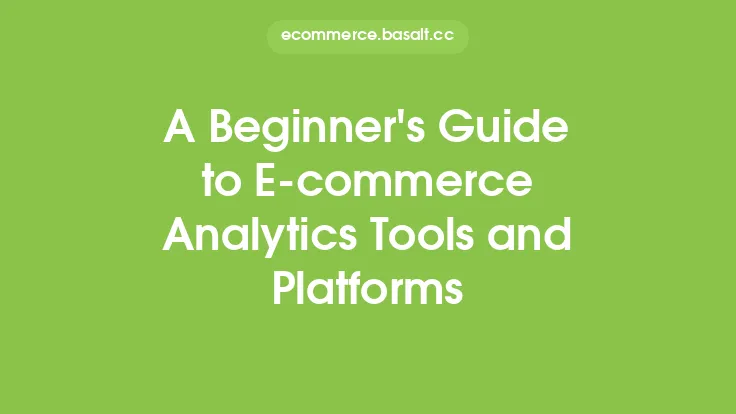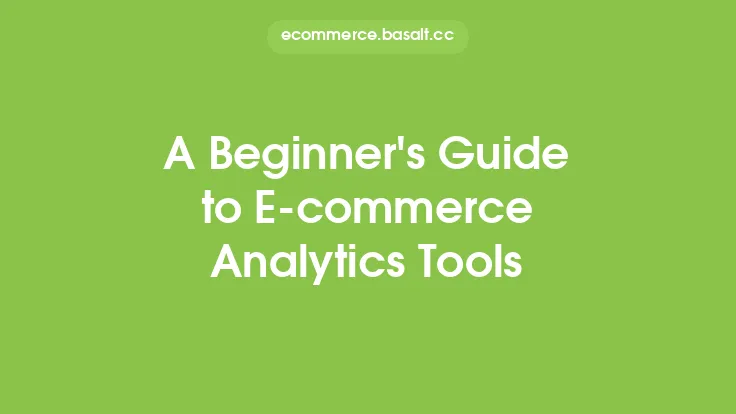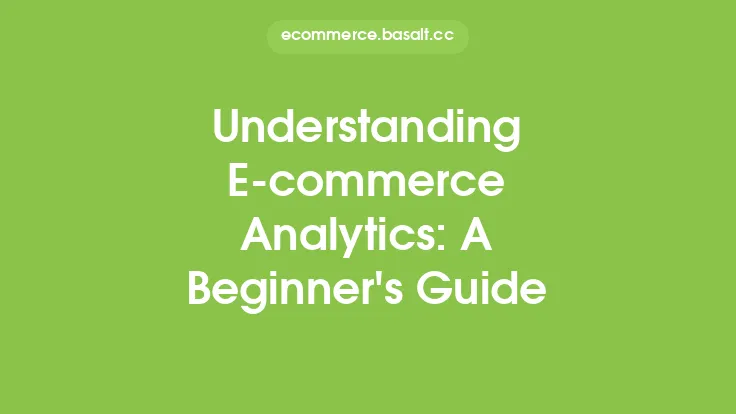In the world of e-commerce, data is king. With the vast amount of information available, it can be overwhelming to navigate and make sense of it all. This is where e-commerce analytics tools and platforms come in – to help businesses make data-driven decisions, optimize their online stores, and ultimately drive growth. In this article, we will delve into the world of e-commerce analytics tools and platforms, exploring the different types, features, and benefits they offer.
Introduction to E-commerce Analytics Tools
E-commerce analytics tools are software applications designed to collect, analyze, and interpret data from various sources, such as website traffic, sales, customer behavior, and marketing campaigns. These tools provide insights into how customers interact with an online store, helping businesses identify areas of improvement, optimize their marketing strategies, and increase revenue. With the numerous options available, it's essential to understand the different types of e-commerce analytics tools and their capabilities.
Types of E-commerce Analytics Tools
There are several types of e-commerce analytics tools, each serving a specific purpose. Some of the most common types include:
- Web analytics tools: These tools track website traffic, behavior, and conversion rates, providing insights into how customers interact with an online store.
- Social media analytics tools: These tools monitor social media performance, tracking engagement, reach, and conversions.
- Customer analytics tools: These tools focus on customer behavior, providing insights into demographics, preferences, and purchasing habits.
- Marketing analytics tools: These tools track the performance of marketing campaigns, including email, paid advertising, and content marketing.
- Product analytics tools: These tools analyze product performance, including sales, revenue, and customer feedback.
Features of E-commerce Analytics Tools
E-commerce analytics tools offer a range of features, including:
- Data collection and integration: The ability to collect data from various sources, such as website traffic, social media, and customer feedback.
- Data analysis and visualization: The ability to analyze and visualize data, providing insights into customer behavior and business performance.
- Reporting and dashboards: The ability to create custom reports and dashboards, providing a clear overview of key performance indicators (KPIs).
- Segmentation and filtering: The ability to segment and filter data, allowing businesses to focus on specific customer groups or behaviors.
- Predictive analytics: The ability to predict future trends and behavior, based on historical data and machine learning algorithms.
Benefits of E-commerce Analytics Tools
The benefits of e-commerce analytics tools are numerous, including:
- Improved decision-making: By providing insights into customer behavior and business performance, e-commerce analytics tools enable data-driven decision-making.
- Increased revenue: By optimizing marketing strategies, improving customer experience, and identifying areas of improvement, e-commerce analytics tools can help increase revenue.
- Enhanced customer experience: By providing insights into customer behavior and preferences, e-commerce analytics tools can help businesses create a more personalized and engaging customer experience.
- Competitive advantage: By leveraging e-commerce analytics tools, businesses can gain a competitive advantage, staying ahead of the competition and adapting to changing market trends.
Popular E-commerce Analytics Platforms
Some popular e-commerce analytics platforms include:
- Google Analytics: A web analytics tool that provides insights into website traffic, behavior, and conversion rates.
- Adobe Analytics: A comprehensive analytics platform that offers advanced features, such as predictive analytics and customer segmentation.
- Shopify Analytics: A built-in analytics tool for Shopify stores, providing insights into sales, customer behavior, and marketing performance.
- Mixpanel: A product analytics tool that focuses on customer behavior, providing insights into demographics, preferences, and purchasing habits.
- Salesforce Commerce Cloud: A comprehensive e-commerce platform that offers advanced analytics and reporting features.
Choosing the Right E-commerce Analytics Tool
With the numerous options available, choosing the right e-commerce analytics tool can be overwhelming. When selecting a tool, consider the following factors:
- Business goals and objectives: Align the tool with your business goals and objectives, ensuring it provides the necessary insights and features.
- Data complexity: Consider the complexity of your data, ensuring the tool can handle large volumes of data and provide meaningful insights.
- Integration: Ensure the tool integrates with your existing systems and platforms, such as e-commerce platforms, CRM systems, and marketing tools.
- Scalability: Choose a tool that can scale with your business, providing flexibility and adaptability as your business grows.
- Cost: Consider the cost of the tool, ensuring it fits within your budget and provides a strong return on investment.
Implementing E-commerce Analytics Tools
Implementing e-commerce analytics tools requires a strategic approach, including:
- Setting clear goals and objectives: Define what you want to achieve with the tool, ensuring it aligns with your business goals and objectives.
- Collecting and integrating data: Collect data from various sources, integrating it into the tool to provide a comprehensive view of your business.
- Configuring and customizing: Configure and customize the tool to meet your specific needs, ensuring it provides meaningful insights and features.
- Analyzing and interpreting data: Analyze and interpret the data, providing insights into customer behavior and business performance.
- Taking action: Take action based on the insights, making data-driven decisions to optimize your online store and drive growth.
Best Practices for Using E-commerce Analytics Tools
To get the most out of e-commerce analytics tools, follow these best practices:
- Monitor and track key performance indicators (KPIs): Focus on key metrics, such as conversion rates, average order value, and customer retention.
- Segment and filter data: Segment and filter data to focus on specific customer groups or behaviors.
- Use predictive analytics: Leverage predictive analytics to forecast future trends and behavior.
- Integrate with other tools and platforms: Integrate the tool with other systems and platforms, such as e-commerce platforms, CRM systems, and marketing tools.
- Continuously monitor and optimize: Continuously monitor and optimize the tool, ensuring it provides meaningful insights and features.
Common Challenges and Limitations
While e-commerce analytics tools offer numerous benefits, there are common challenges and limitations to consider, including:
- Data quality and accuracy: Ensuring data quality and accuracy is crucial, as poor data can lead to misleading insights.
- Data overload: With the vast amount of data available, it can be overwhelming to navigate and make sense of it all.
- Integration and compatibility: Ensuring the tool integrates with existing systems and platforms can be challenging.
- Cost and budget: E-commerce analytics tools can be expensive, requiring a significant budget and resource allocation.
- Skill and expertise: Using e-commerce analytics tools requires specialized skills and expertise, which can be a challenge for small businesses or those with limited resources.
Future of E-commerce Analytics
The future of e-commerce analytics is exciting, with emerging trends and technologies, such as:
- Artificial intelligence (AI) and machine learning (ML): AI and ML will play a significant role in e-commerce analytics, enabling predictive analytics and automated decision-making.
- Internet of Things (IoT): The IoT will provide new sources of data, enabling businesses to track customer behavior and preferences in real-time.
- Augmented reality (AR) and virtual reality (VR): AR and VR will change the way customers interact with online stores, providing new opportunities for e-commerce analytics.
- Cloud computing: Cloud computing will enable businesses to scale and adapt quickly, providing flexible and secure data storage and analysis.
Conclusion
E-commerce analytics tools and platforms are essential for businesses looking to drive growth, optimize their online stores, and make data-driven decisions. By understanding the different types, features, and benefits of e-commerce analytics tools, businesses can choose the right tool for their needs and implement it effectively. With the ever-evolving landscape of e-commerce analytics, it's essential to stay up-to-date with the latest trends and technologies, ensuring businesses remain competitive and adaptable in a rapidly changing market.





